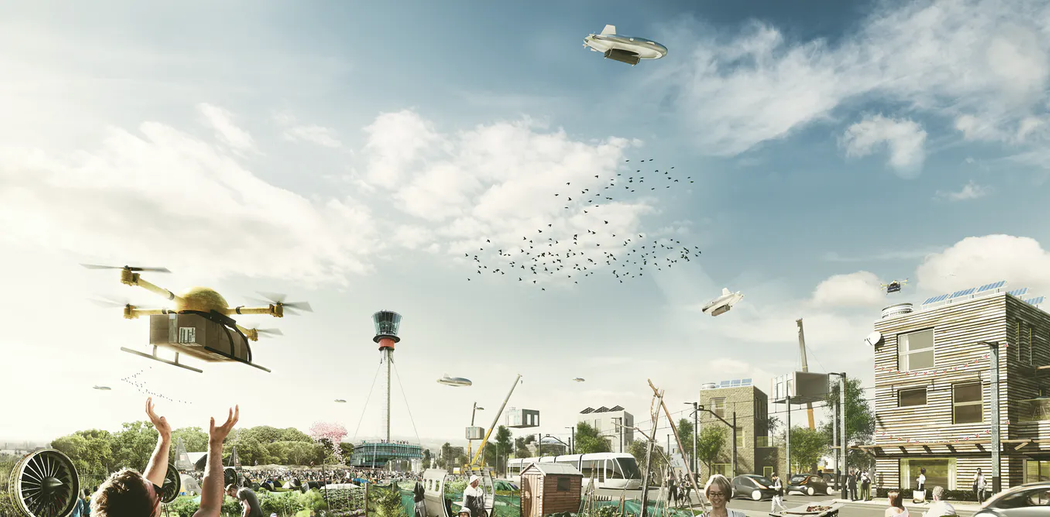This is the second article in a series about emerging technology and insurance. Other articles include:
History of Drones
Upon creation of the Royal Air Force in 1918, the UK needed effective methods for training pilots. Target practice entailed towing gliders behind crewed aircraft. However, that method failed to provide a realistic simulation for engaging enemy fighters in live combat. So in 1935, the De Havilland DH.82B Queen Bee aircraft came into existence as a low-cost radio-controlled drone developed for aerial target practice. The Queen Bee was the first modern drone.
3D printing and affordable consumer models significantly lowered the financial bar of owning a drone.
Since 1935, drones have existed as specialty tools, primarily for military reconnaissance and in niche hobby scenes. In the 2000s, drones had a breakout moment as cultures, content, and open source collaboration moved online, powering the consumer drone hobbyist scene. 3D printing and affordable consumer models significantly lowered the financial bar of owning a drone. 3D printing and open source design allowed for everyday consumer to manufacture replacement parts easily and affordably from the comfort of their own homes creating a thriving hobbyist community.
This led to the cost of manufacturing sensors decreasing dramatically. These new sensors opened up new applications for drones in both consumer and professional applications. Affordable sensors not only decreased the final price point, but enabled experimentation. Whereas before a drone may cost in the hundreds of thousands, a drone that cost a few thousand was expendable. This expendability and ubiquity is powering the future of the drone economy.
Drones Today
Outside the well documented (and potentially infamous) applications of military drones, they have a variety of applications in both the commercial and the insurance space. More are created every day.
Among the most prevalent are companies that use drones to survey land and property to build catastrophic flood, fire, and wind risk and other property related risk maps. Drones are also seeing use to assess property claims in unstable or hazardous areas post catastrophe. A real world example is the failed Fukushima Daiichi nuclear power plant. Drones are being developed that can autonomously navigate in a confined, GPS-denied environment, avoiding obstacles along the flight path, and surviving the radiation levels expected during a mission inside the collapsing power plant.
Other use cases include:
- Powered by AI and computer vision, drones have also adopted the role of mobile security and surveillance.
- In agriculture, farmers are using drones to assess crop viability over large pieces of land.
- Universities are experimenting using drones to distribute vectors for pest and disease control.
Drones Tomorrow
Especially for traversing large distances, it is still more time and cost effective to collect data and deliver packages, using fossil fuel powered vehicles.
Artificial intelligence is enabling the use of drones to deliver packages and people as the technology matures. The path to adoption for these future applications of drones is riddled with practical and legislative obstacles. In the US, regulators require licensed drone operators to maintain a clear line of sight of their drone. This additional redundancy significantly reduces the financial viability of commercial drone applications due to labor costs. However, the Federal Aviation Administration recently gave permission in January 2021 for a private company to conduct autonomous commercial drone flights.This momentous decision will open up autonomous commercial flights for other companies, leading to a proliferation of drone technology and usage.
Technological challenges for drones center on the current limitations of weight to battery capacity. Especially for traversing large distances, it is still more time and cost effective to collect data and deliver packages, using fossil fuel powered vehicles. As battery technology continues to develop, the applicability of drones will increase exponentially. The urban landscape will also change to accommodate the use of drones. From communal drone landing pads and universal charging stations, cities will build ‘drone friendly’ features which will increase the utility of drones.
What does this mean for Insurance?
Imagine a scenario where you got in a car accident. Rather than calling 911 for potential injuries and waiting for 60-90 minutes for an ambulance and law enforcement to assess a scene, your phone or onboard system will send out a distress message. This will trigger a drone to fly out in less than 10 minutes to assess the scene of the accident, health of the drivers, and damage to the vehicles. They relay this data in real-time to emergency services so they show up prepared for the situation and to your insurance company to give a more accurate representation of the accident and expedite the claims process.
Assuming there were no injuries sustained in the accident, the insurance company now has the data to send both a tow truck to transport your vehicle to an adjuster and body shop and a rental car to the site of the accident so you could continue your day as if nothing happened — saving hours of time, paperwork and providing unbeatable customer service.
To prepare for this opportunity, insurance brokers should understand how their insureds use drones - in a personal or commercial capacity.
This is simply one of the amazing future use cases for drones. On the insurance side today, drone applications are still undergoing pilots (pun intended). Many insurance companies today cannot receive, handle, and effectively use the vast quantity and variety of data drones offer at scale. These siloed legacy systems will continue to buckle under technological advancements, and nonstop challenges will continue to emerge for startups until the industry creates data and API standards to connect their systems.
To prepare for this opportunity, insurance brokers should understand how their insureds use drones - in a personal or commercial capacity. It is extremely important to educate commercial clients about the risk that drones possess, so that when they purchase one, their insurance agent is the next call they make. Wholesalers should position themselves so that they are working with the handful of forward-thinking carriers that currently offer drone-related policies. Last, carriers should dedicate time and resources to explore personal and commercial drone offerings. A key piece of this preliminary research is triggers that would signal to the carrier that it is time to launch the policy.
It is never too early to be thinking about the future. And if you are thinking about the future, think about drones.






